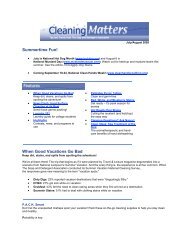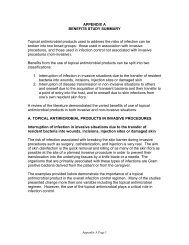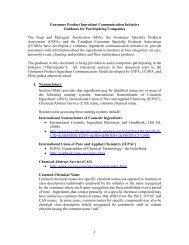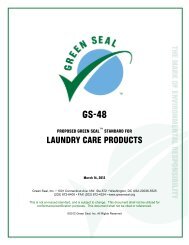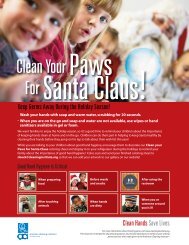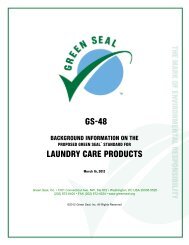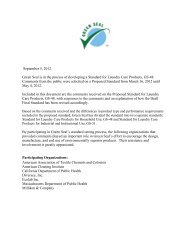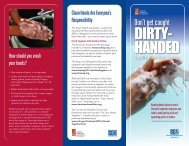subchapter c -- federal hazardous substances act regulations
subchapter c -- federal hazardous substances act regulations
subchapter c -- federal hazardous substances act regulations
You also want an ePaper? Increase the reach of your titles
YUMPU automatically turns print PDFs into web optimized ePapers that Google loves.
conditions in accordance with the<br />
manuf<strong>act</strong>urer’s instructions.<br />
(2) The oscilloscope shall be the storage<br />
type or one equipped with a camera. It shall<br />
have a response uniform to within ±1 decibel<br />
from 50 hertz to 250 kilohertz or higher. It<br />
shall be calibrated to within ±1 decibel against<br />
an external voltage source periodically during<br />
the tests.<br />
(b) Procedure. (1) Use the type pistol that<br />
would ordinarily be used with the caps being<br />
tested. Place the pistol and testing equipment<br />
so that neither the pistol nor the microphone is<br />
closer than 1 meter from any wall, floor,<br />
ceiling, or other large obstruction. Locate the<br />
pistol and the microphone in the same<br />
horizontal plane with a distance of 25<br />
centimeters between the diaphragm of the<br />
microphone and the position of the explosive.<br />
Measure the peak sound pressure level at each<br />
of the six designated orientations of the pistol<br />
with respect to the measuring microphone. The<br />
0° orientation corresponds to the muzzle of the<br />
pistol pointing at the microphone. The 90°,<br />
180°, and 270° orientations are measured in a<br />
clockwise direction when looking down on the<br />
pistol with its barrel horizontal, as illustrated<br />
by the following figure:<br />
(2) The hammer and trigger orientations<br />
are obtained by rotating the pistol about the<br />
axis of the barrel, when the pistol is in the 90°<br />
or 270° orientation, so that the hammer and the<br />
trigger are each respectively closest to and in<br />
the same horizontal plane with the<br />
microphone.<br />
(3) Fire 10 shots at each of the six<br />
orientations, obtaining readings on the<br />
oscilloscope of the maximum peak voltage for<br />
each shot. Average the results of the 10 firings<br />
for each of the six orientations.<br />
(4) Using the orientation that yields the<br />
highest average value, convert the value to<br />
16 CFR Ch. II (1–1–05 Edition)—proposed modificication – 6/25/06<br />
-- 49 --<br />
sound pressure levels in decibels relative to 20<br />
micronewtons per square meter using the<br />
response to the calibrated measuring<br />
microphone.<br />
§ 1500.48 Technical requirements for<br />
determining a sharp point in toys and other<br />
articles intended for use by children under<br />
8 years of age.<br />
(a) Objective. The sharp point test<br />
prescribed by paragraph (d) of this section will<br />
be used by the Commission in making a<br />
preliminary determination that points on toys<br />
and other articles intended for use by children<br />
under 8 years of age, and such points exposed<br />
in normal use or as a result of reasonably<br />
foreseeable damage or abuse of such toys and<br />
articles, present a potential risk of injury by<br />
puncture or laceration under section 2(s) of the<br />
Federal Hazardous Substances Act (15 U.S.C.<br />
1261(s)). The Commission will further<br />
evaluate points that are identified as presenting<br />
a potential risk of puncture or laceration injury<br />
to determine the need for individual product<br />
regulatory <strong>act</strong>ion.<br />
(b) Scope — (1) General. The sharp point<br />
test of paragraph (d) of this section is<br />
applicable to toys or other articles that are<br />
introduced into interstate commerce on or after<br />
December 22, 1978. The sharp point test shall<br />
be applied to any accessible portion of the test<br />
sample before and after subjecting the test<br />
sample to the use and abuse tests of §§<br />
1500.51, 1500.52, and 1500.53 (excluding the<br />
bite test-paragraph (c) of each section).<br />
(2) Exemptions. (i) Toys and other<br />
children’s articles that are the subject of any of<br />
the following <strong>regulations</strong> are exempt from this<br />
§ 1500.48: The <strong>regulations</strong> for bicycles, nonfull-size<br />
baby cribs, and full-size baby cribs<br />
(parts 1508, 1509, and 1512, of this chapter).<br />
(ii) Toys that by reason of their functional<br />
purpose necessarily present the hazard of sharp<br />
points and that do not have any nonfunctional<br />
sharp points are exempt from this § 1500.48:<br />
Provided, Each toy is identified by a<br />
conspicuous, legible, and visible label at the<br />
time of any sale, as having functional sharp<br />
points. An example of such toys is a toy<br />
sewing machine with a needle.<br />
(iii) Articles, besides toys, intended for use<br />
by children that by reason of their functional<br />
purpose necessarily present the hazard of sharp<br />
points and that do not have any nonfunctional



